'Postcards From Ukraine' Project Shows Devastation To Ukraine Culture By Russian Invasion
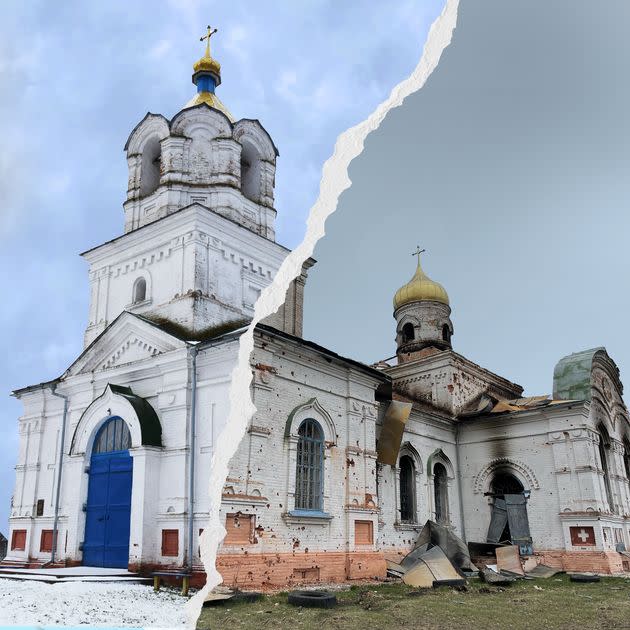
Ascension Church in Lukashivka in the Chernihiv region of Ukraine. (Photo: Before: Wikimedia Commons; After: Nataliya Gumenyuk / Ukrainian Institute)
More than six months after the Russian invasion of Ukraine started, with thousands dead and many cities demolished, one organization is keeping track of another aspect lost in the war ― Ukrainian cultural sites.
The Ukrainian Institute’s “Postcards from Ukraine” project documents before-and-after images of historic sites and buildings damaged by Russian troops, combining them to show the dramatic contrast between the past and present. The organization is encouraging people to share the postcards on social media in order to record the damage done to these Ukrainian landmarks.
See more images from the “Postcards from Ukraine” project below:

Lysychansk gymnasium was a striking example of Belgian architecture in Lysychansk, a city in eastern Ukraine. It is part of the complex comprising a soda factory and a residential complex for employees and workers built by Belgian entrepreneur and philanthropist Ernest Solvay in the late 19th century. On May 1, it was destroyed by Russian shelling and the resulting fire. (Photo: Sergey Gaidai / Ukrainian Institute)
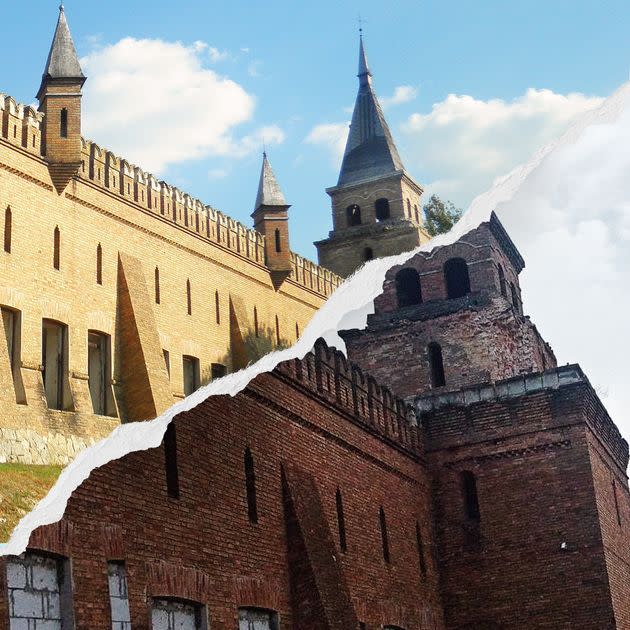
Popov Manor House is one of the most prominent aristocratic estates of the late 18th and early 19th centuries in southern Ukraine and a landmark of regional history and architecture. During shelling on March 7, the Russian military damaged the walls of the horse stable and other buildings and looted the local museum. (Photo: Before: Irina Miroshnikova ; After: Anna Golovko / Ukrainian Institute)
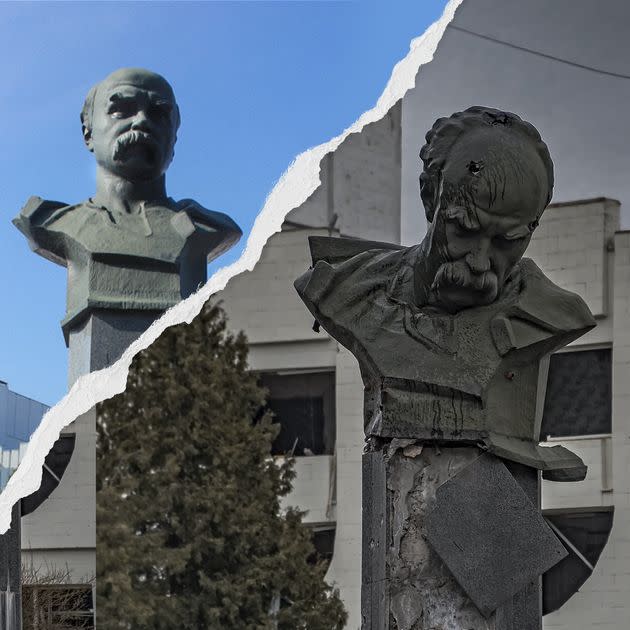
Shot in the forehead by Russian troops in Borodianka, near Kyiv, the monument to Ukraine’s greatest poet Taras Shevchenko, an iconic figure in the development of modern Ukrainian culture, became one of the symbols of the 2022 Russian invasion of Ukraine. (Photo: Before: Nin_gen/Livejournal ; After: Ukrainian Institute / Ukrainian Institute)
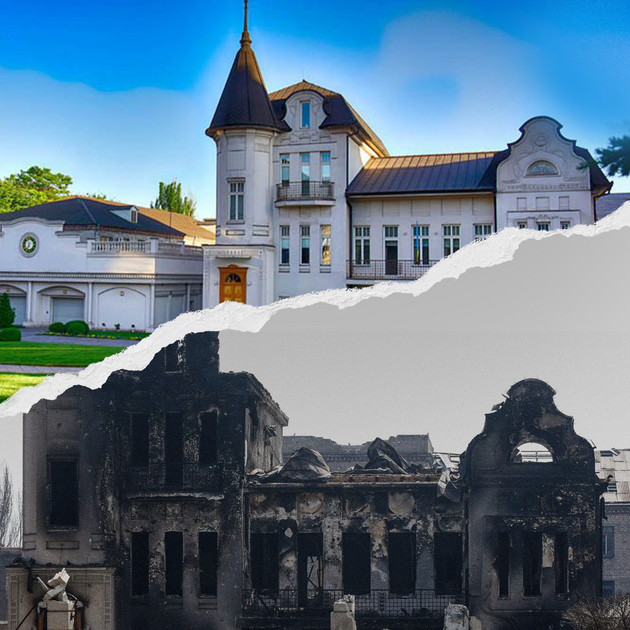
This elegant estate belonged to Abram Trehubov, a local businessman who owned a significant portion of Mariupol’s downtown and whose property was seized following the 1917 Bolshevik Revolution. In Soviet times, the manor served as a clinic and blood transfusion center; only after the restoration of Ukraine’s independence was it reconstructed to its original design. On Feb. 24, three historical buildings on the Trehubov estate were damaged by Russian shelling. (Photo: Before: lb.ua ; After: Alexander Ermochenko/Reuters / Ukrainian Institute)

The Azovstal plant in Mariupol was one of the biggest producers of iron and steel in Europe with more than 10,000 workers. In 2022, the Azovstal shelters were a refuge for over 1,000 civilians, mostly women and children. The Russian forces stormed and bombarded the enterprise for weeks. Eventually, civilians and the injured were successfully evacuated. (Photo: Before: visitdonbass.info ; After: unian.net / Ukrainian Institute)
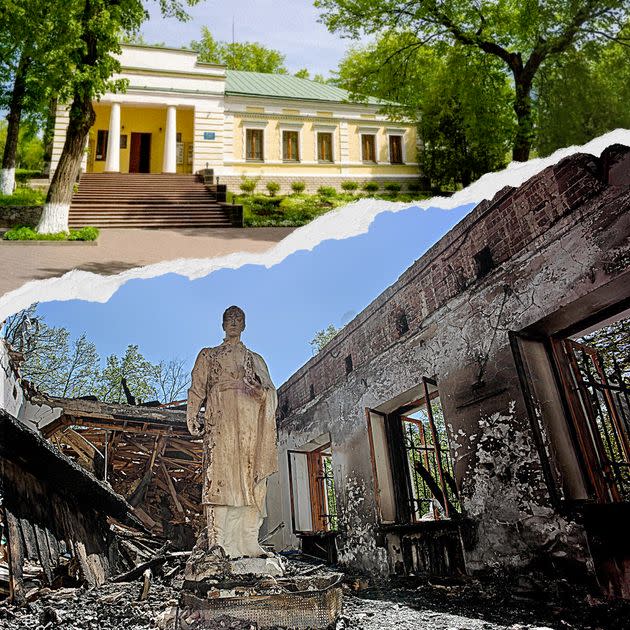
The Hryhorii Skovorda museum is devoted to a prominent Ukrainian philosopher, theologian, and poet who had a significant impact on multiple generations of Ukrainians. The philosopher's works, his favorite books, and other personal belongings are displayed in an 18th-century museum building. The philosopher's grave is located nearby. His tombstone reads: “The world tried to capture me, but didn't succeed.” On May 7, 2022, the Russian military shelled the building's roof, setting the entire museum on fire. (Photo: Before: find-way.com.ua ; After: Sergey Kozlov / Ukrainian Institute)
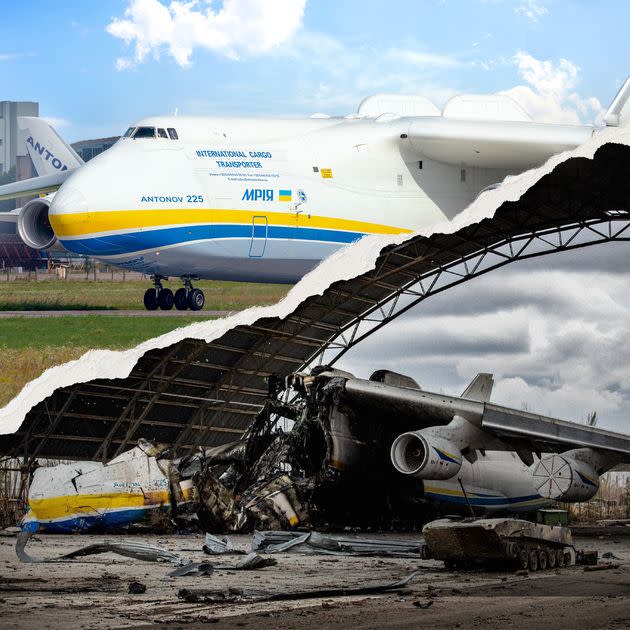
The AN-225 "Mriia" cargo plane. Since its construction in the 1980s,the one-of-a-kind cargo plane designed to transport objects for the space industry has set more than 240 world records for speed, altitude, and load capacity. It was destroyed and burned during the March 27 Russian attack on Hostomel. (Photo: Before: Ukrainian Institute ; After: @dobriyranokkyiv/t.me / Ukrainian Institute)
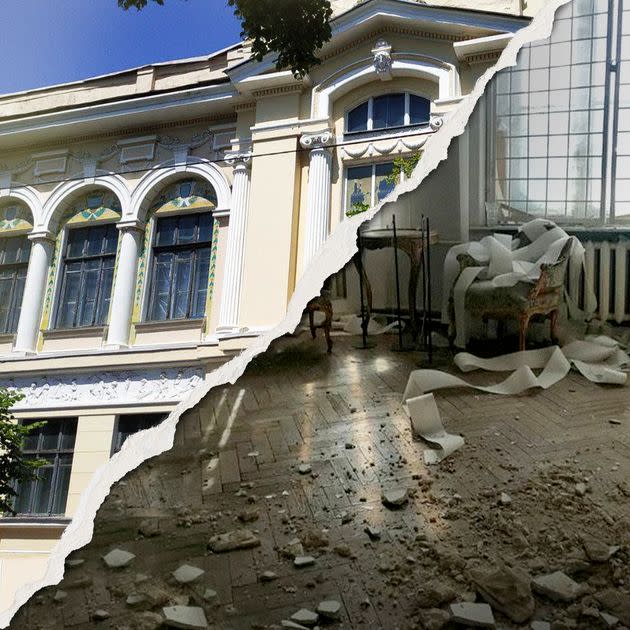
The building that houses the Kharkiv Art Museum today was designed by acclaimed architect Oleksii Beketov and erected in 1912-1914 on commission from the Kharkiv millionaire and industrialist Ivan Ihnatishchev. It became a museum in 1944 and had since expanded its collection to 25,000 exhibits of Western European, Ukrainian and Russian painting, graphics and sculpture, covering the period from the 15th to the 21st century. During the shelling of Kharkiv in February, the Russian troops damaged the façades, windows and stained glass of the building. (Photo: Before: x-vymir.com; After: Maryna Filatova / Ukrainian Institute)
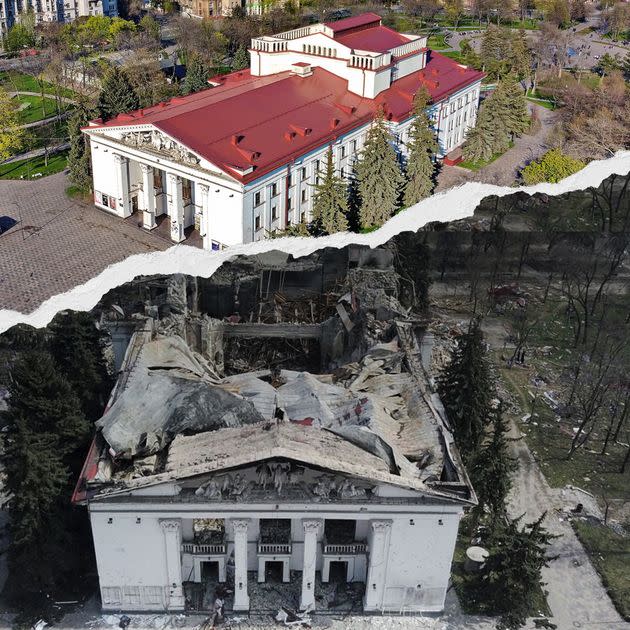
The only professional theater in Mariupol, Donetsk Academic Regional Drama Theatre, was constructed in the 1950s in the style of monumental Soviet classicism. After Russian bombing on March 16, this city’s cultural center became a mass grave for hundreds of children and adults hiding there, becoming a symbol of the humanitarian catastrophe in Ukraine. (Photo: Before: Wikimedia Commons; After: radiosvoboda.org / Ukrainian Institute)
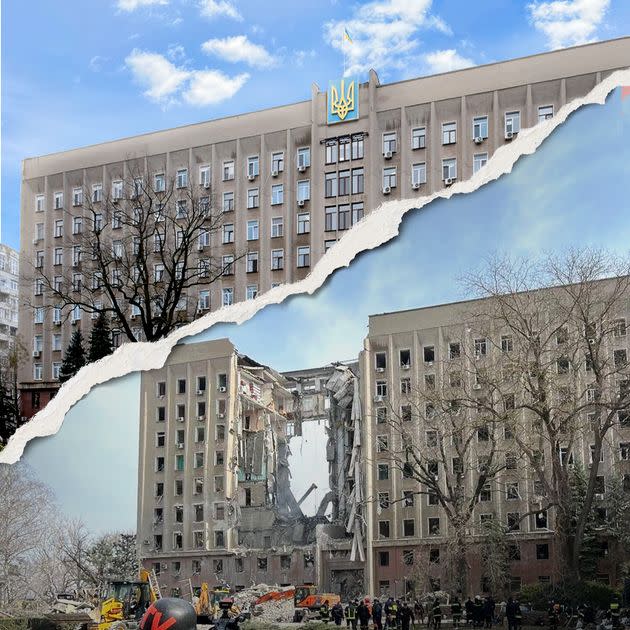
Mykolaiv Regional State Administration building. During the 19th century, Mykolaiv became the center of shipbuilding in the Black Sea area. (Photo: Before: nikvesti.com ; After: misto.vn.ua / Ukrainian Institute)
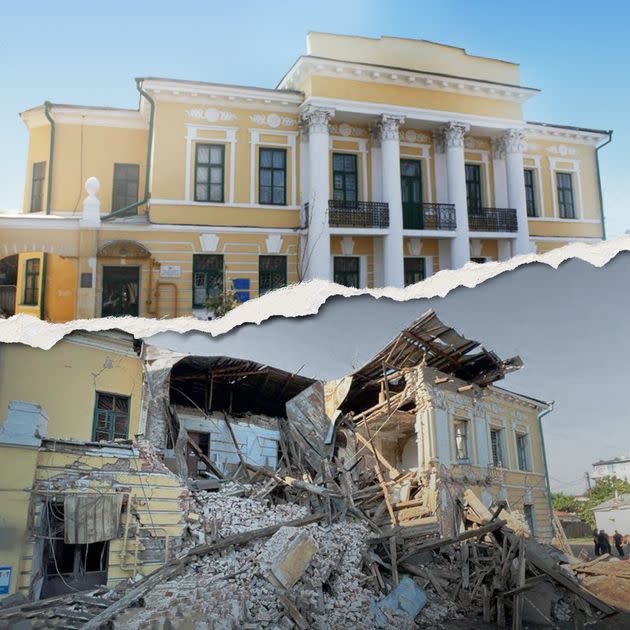
The Pavlov estate still preserves memories of Kharkiv’s vibrant urban life in the 19th century. The Pavlovs were local officials, and their family residence was built in 1832. Balls, dinner parties, and receptions were held on the first floor. The estate later became a hotel and then was turned into a command center for specialized military after the Bolsheviks’ takeover of power in Ukraine. The oldest street in Kharkiv, Poltavskyi Shliakh, was struck by Russian shells on July 6. The Pavlov manor was destroyed: Its facade was ruined, and significant fissures appeared on the remaining walls. (Photo: Before: ua.igotoworld.com ; After: Kharkiv Regional Prosecution Office / Ukrainian Institute)
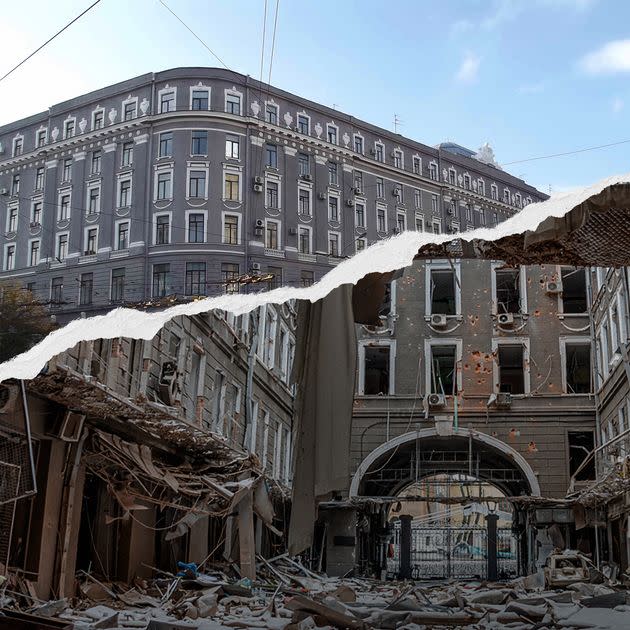
The art nouveau and neoclassical-style Palace of Labor is an illustrious part of the architectural ensemble of Kharkiv’s Constitution Square. It is a former rental house, which, after the Bolsheviks conquered Ukraine, became an office for trade unions. Its architect, Hyppolite Prétreaus, perished in 1937 during the Stalinist terror. A Russian airstrike in the spring of 2022 destroyed Constitution Square and damaged the building's facades, windows and roof. (Photo: Before: Wikimedia Commons; After: redpost.com.ua / Ukrainian Institute)
This article originally appeared on HuffPost and has been updated.
